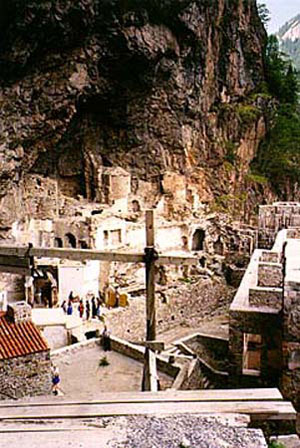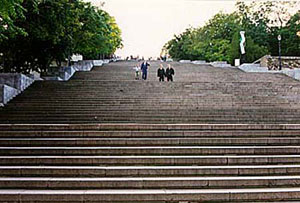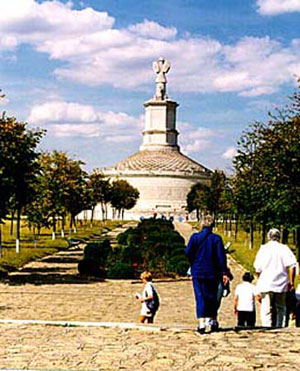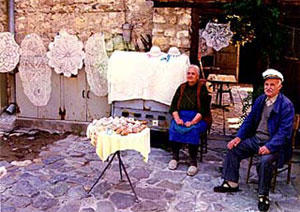 |
|
|
|
|
|
|
|
|
|
|
|
|
|
|
|
|
|
|
|
|
|
|
 |
 |
|
|
|
|
|
|
|
|
|
|
|
|

|
A Voyage on the Black Sea
The Hospitable Shores At the reception preceding the Captain's Farewell Dinner aboard Clelia II, Harold Douthit, a newspaper publisher from Ohio, pinned a medal on the lapel of Captain Abdel Saidini's white dinner jacket and bused him French style. The pin was one of a collection of 47 different and colorful Russian military medals that Douthit bought for $5 in Odessa, a stop on the itinerary, "The Hospitable Shores: A Voyage on the Black Sea." The impeccably dressed captain, a partner in Classical Cruises, the company that charters Clelia II from a Greek shipping family, responded with the same Continental aplomb with which he had conducted himself during the sailing. Classical Cruises' forte is its scholarly lectures, exotic and sometimes little visited ports and educational excursions that are included in the price and are strong on museums, archeology, architecture, history and nature. The line attracts passengers who are more interested in a learning experience than they are in the glitz and glamour usually associated with cruising. A two-day stay at the Istanbul Hilton, one of our favorite hotels in that city because of its Oriental motif and parklike setting, preceded the cruise. Immersion in Greek, Roman, Ottoman, Byzantine, Scythian and Dacian cultures that layer the region began at the Hilton with discussions about "The Byzantine Empire" and "From Constantinople to Istanbul." Sightseeing at the Archeological Museum, Hagia Sophia, Blue Mosque, Topkapi Palace and Hippodrome deepened our understanding of the material. www.hilton.com/en/hi/hotels/index.jhtml?ctyhocn=ISTHITW The curator of classical art at the Museum of Fine Arts in Boston, as well as a Princeton Near East studies and a Yale history professor delivered 11 compelling talks in all, where the attendance was 60 to 90 percent of the guests. On tour the scholars augmented the information presented by local guides. We also had access to the experts at other times and were able to continue the discourse through informal conversations. Istanbul is not on the Black Sea, but at the confluence of the Marmara and the Bosporus, the narrow 19-mile-long strait that separates European and Asian Turkey and joins both seas. Because of the interweaving of commerce, civilizations and conquerors, Istanbul shares a heritage with the rest of the region. During Homeric years, the sea was not easily navigable and was called `Axenos' (inhospitable) and said to be filled with Amazons, two-headed men and other mythic creatures. The lands surrounding the sea buffered the early colonizers from the barbarians. Later when the Ionians founded cities on the shores, it became known as `Euxeinos' (welcoming to strangers). In classical times the Ancient Greeks also referred to the sea as friendly because they fished in its waters. Merchants came here to trade wheat, spices, silk and slaves. According to Curator John Hermann pottery, blown glass, jewelry, statues and coins were exported from the Greco-Roman world to the colonies surrounding the sea and these collective artifacts along with trade helped to integrate the territories. Coinage especially reveals what happened during particular periods. After the Moslem conquest of Constantinople in 1453, the Ottoman Empire ruled these diverse peoples who lived and prospered together. With the breakup of the empire after World War I, national groups were realigned and Turkey, restructured by Atatürk, eventually became a major power. The cruise's theme was the retelling of the interminable narrative leading to today's political and social world. The specialists delivered pertinent talks such as "Ottoman Institutions," "The Psychology of Ethnic Conflict" and "Atatürk." Development of the arts in the domains near the sea was also emphasized. In almost every town we visited archeological museums. With the exception of Istanbul, we called at seven ports where tourism is not highly developed. Nevertheless we rode in modern air-conditioned buses and were escorted by experienced and informed guides. Participation in the tours was usually 100 percent. TRABZON, TURKEY Known as the Switzerland of Turkey because of the Alpine climb to the ruins of Sumela, a former Greek Orthodox monastery perched on a sheer rock, Trabzon averages about 1000 tourists each year. The crooked climb (one kilometer straight up) to the monastery, located in an evergreen-filled national park with a rocky stream rushing through it, is steep and for the sure-footed only. But you can see Sumela from the valley where you can also observe Turkish families strolling, socializing and picnicking.
The Hagia Sophia or Church of the Divine Wisdom, the second most significant site in the city and overlooking the coastal highway, has some of the world's best preserved and restored Byzantine frescoes and mosaics. The story of many eras is painted on and carved into its walls. Built like a Greek church, it was, before becoming a museum, a mosque in one of its previous metamorphoses. And finally, there is Attatürk's villa. A shrine to the father of modern Turkey, who turned the country into a secular Islamic society, it is filled with memorabilia, especially photographs. SOCHI, RUSSIA Initially we contemplated wandering about Sochi, the country's largest hydrotherapy resort, on our own--visas are no longer needed in Russia for cruise passengers staying less than 48 hours-- but we were intimidated by the city's sprawl. A 13-kilometer motor coach drive next to the stony beach and with a view of the Caucasus took us through the verdant countryside to the Dagomys Tea Plantation with its samovar museum and dacha for a tea tasting and an animated folk song and dance performance. YALTA and SEVASTOPOL, UKRAINE On the way to Yalta's Livadia Palace, the former czar's residence where Churchill, Stalin and Roosevelt met in 1945, we passed the promenade along the shore and the pretty center with its Lenin Square and outdoor markets. The ship sailed to Sevastopol while we drove the 80-kilometer winding highway sandwiched between the Crimean Mountains and the Black Sea. One of the great drives of the world, we passed the villa from which Gorbachev was kidnapped and Swallow's Nest (symbol of Yalta), suspended like a gingerbread castle on a precipice over the sea. We paused at a homey restaurant to eat a typical lunch of pirogi, borscht and stew before going on to Chersonesus, the Greek's northernmost colony and most important classical site in these parts. The excavation includes walls, a citadel, agora, main street, basilica, amphitheater and mint. Also on the grounds of this 22 B.C. settlement lasting 2000 years are several museums housing antiquities, a fog bell and the remains of a 19th-century cathedral. And then, there was time for a stroll on the main concourse to see the kiosks, august buildings, neatly manicured parks and people gathering to attend the theater. ODESSA The scene took place in Odessa's 130-year-old Renaissance-style Londonskaya Hotel, but we could have been sitting in a regal restaurant in any of Europe's fashionable capitals and listening to renowned opera singers and musicians entertain us at lunch while we feasted on sensational chicken Kiev.
With three presentations, including a choir recital at the Uspensky Cathedral, home to a collection of priceless icons, and a command performance of the Ukrainian Armed Forces Song and Dance Ensemble at Philharmonic Hall, it was music day in the "Pearl of the Black Sea." Founded by Catherine the Great in 1794, laid out by two Frenchmen and graced with a sprinkling of Italian architecture, Odessa was quite cosmopolitan by the 19th century. One Russian writer wrote that "the town was always dressed up and holidaylike," and another called it, "a rather unkempt jewel." We agree with the former. The "Paris of the East" as it was also named is replete with imperial palaces and stately statues of illustrious former citizens, is dotted with inviting parks and squares and is crossed with grand boulevards. The Potemkin Steps immortalized in Sergey Eisenstein's 1925 film are commanding. The notable relics and gold exhibited in the Archeology Museum are gems among collections.
But the best activity in Odessa is people watching: elderly babushkas huddling over grandchildren in Prymorsky Park, ravishing Natashas chicly clad in Versace and Armani sauntering along Deribassovskaya and vendors crowding Gorsad (city garden) to peddle matryosha dolls and other souvenirs. CONSTANTA, ROMANIA When speaking of the destruction inflicted on Romania by the barbarous Ceausescu regime and the difficult transition from Communism, our guide in Constanta quipped, "We've only been at it for nine years. Give us another 200 to see how we're doing." For the visitor, the tours of the awesome archeological sites and museums offset the sad sight of the dreary city and the poverty in the countryside where people still travel in horse drawn wagons to till the fields. Perhaps as a paean to optimism they grow brilliant blossoms in the gardens of their tiny cottages. Constanta, once one of the farthest outposts of the Roman Empire, lies on the ancient site of Tomis. The reconstructed cylindrical Tropaeum Traini in the museum complex of Adamclisi commemorates Emperor Trajan's conquest of the Dacians in 108. The original sculptures have been removed to the museum and are remarkable for their details depicting ancient battles. Adjacent to the Museum of Natural History and Archaeology is a large enclosed mosaic floor dating from Roman times.
NESSEBUR, BULGARIA If there was a surprise stop on the schedule, Nesseber was it. Combining charm, churches and kitsch, the contrast between solemnity and frivolity in this living museum was unexpected. Founded by Greeks as Messembria about 500 B.C., eight of its 48 medieval churches remain in good condition with exteriors that were built with multicolored bricks arranged in dissimilar, but attractive patterns. More recent Bulgarian homes have timber tops sitting on stone bases and jutting out over the lanes. The ancient town lies on a peninsula and is linked by a causeway to a modern city on the mainland. This lovely resort is visited in season by several thousand vacationing tourists. Hence, the goodly number of shops selling pottery, painted wood and crocheted doilies, along with an overwhelming amount of junk. By exclusive arrangement, Classical Cruises leases Clelia II for 11 months each year. Compagnie des Iles du Ponant, a group based in Nantes, France, operates the vessel and, therefore, many of the 55 crew members were French. The cruise director and tour managers were employees of Travel Dynamics, an American-based company, of which Classical Cruises is a division. With long years of involvement in the industry, they did an excellent job of coordinating shore excursions, responding to individual passengers' requests and answering questions during the disembarkation briefings.
The present owner, who considers Clelia II to be a private yacht, purchased the former Renaissance IV as a gift for his daughter. The accommodations were reconfigured into 42 outside suites, including several penthouses and apartments on the top two decks. In 1997, after a total refurbishing and the addition of deluxe features, he rechristened the boat. At 225 square feet our standard cabin on the Columbus Deck was spacious and comfortable. Panelled in dark wood with a mirrored wall, it had three large windows, an extended combination vanity/desk, a VCR, twin beds, a night stand and a sitting area with a sofa, easy chair and coffee table. The closets, shelves and drawers--two had locks--were sufficient even for those who travel with large wardrobes. There were no tubs on the ship, but the shower had a seat. Deluxe penthouses are 520 square feet and have balconies, separate bedrooms and living rooms and two bathrooms. Despite the vessel's small size, the public spaces are roomy and the facilities are ample. The cheerful Golden Star Dining Room with tables for six, eight or 10 and open seating at all meals is done in handsome blond wood and light toned marble. The reception area, Sky Blue Lounge, Nautilus Club and the library, stocked with many good books and videos, are tastefully decorated, too. There is a beauty salon, steam bath, gymnasium, pool, Jacuzzi and outdoor cafe where delicate tuiles and other Gallic treats were set out at tea time. They were so good that concerns about calories were thrown over the rail. Copious buffets with a delicious selection of hot and cold food were served in the morning and at noon. Fruit, yogurt, eggs, ham, cheese, cereal, fluffy pancakes and, of course, brioche and croissants were offered at breakfast. The variety was even greater at lunch--salads, carved roasts, fish, chicken, pasta, vegetables and stews. No Parisian pâtissier could have baked better sweets than the sublime ones on the luncheon dessert table. The set menu dinners needed to be improved. Appetizers and soups were tasty, but the two main courses often were not. The meat was sometimes tough and the fish dry. Provisioning in the Black Sea was said to be a problem, but that did not seem to affect the other meals. Service in the dining room, though well intentioned, was sometimes amateurish. A special room service menu was available and during the hours that the restaurant was open, you could order the regular meal in your cabin. Because of the active and exhilarating days on shore, we ended our evenings after dinner. We don't know if anyone ever made it to the 11 o'clock snack following the evening's entertainment, piano music in the lounge. Nicholas, the pianist, played during the cocktail hours, too, and one evening he gave a classical recital. Dressy attire was suggested for the captain's welcoming and farewell dinners, but no one wore black tie or fancy gowns. We had no access to the International Herald Tribune or CNN, serious business during the time of the falling stock market and the release of the Starr report. News from the BBC was taped and broadcast once a day. For those who could get up early, Valerie, a staff member, led a one-hour workout in the gym. Some guests traveled independently, but most of the 84 passengers were associated with alumni groups--Yale, UCLA and Princeton--and the Boston Museum of Fine Arts. They were, with the exception of six French people, Americans, ranging in age from the 50s through the 80s. Because of the open seating and the fact that we toured in just two buses, everyone got to know everyone else quickly among this friendly interesting group. Vasos Papagapitos, president of the company, likes to say that he handcrafts the itineraries. He spreads nautical charts across his desk and with a protractor he plots times and distances. We were excited by what he had mapped out for us. How else could we have seen Istanbul and Trabzon in Turkey, Sochi in Russia, Yalta, Odessa, and Sevastopol in the Ukraine, Constanta in Romania and Nessebur in Bulgaria and only unpacked twice? And as for the other passengers they, too, seemed very pleased. Our feeling was that the satisfaction barometer aboard Clelia II registered high. In 1999 Clelia II's nine- to 13-day trips will be organized around eight themes sailing along Africa's west coast, in the Aegean and Mediterranean with calls in the Middle East as well as in the Black Sea. The Black Sea itinerary will begin with an optional flight from the U.S. on July 15. Embarkation takes place in Istanbul on July 18. The cruise is eight nights. The airline has not yet been determined. In 1998 the company offered a specially negotiated coach class fare on Lufthansa. Seats were cramped, food was dreadful, there were no amenities and it was necessary to change planes in Frankfurt. Turkish Air, a more comfortable carrier, has direct flights to and from the New York area and Istanbul. Clelia II, Classical Cruises, 132 East 70th Street, New York, NY 10021. Tel. 800-252-7745. Winter 1998-99 |
||||||||||||




